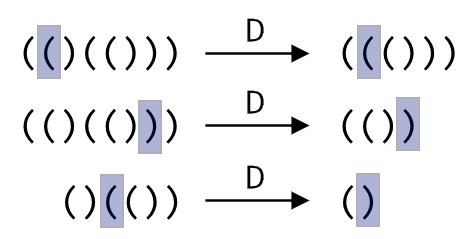CF670E Correct Bracket Sequence Editor
题目描述
`Polycarp`有一个长度为 $n$ 的括号串。
我们设 $pre_i$ 为字符串中第 $1$ 位到第 $i$ 位的左括号数量减去右括号数量,那么当每个 $1\leqslant i\leqslant n$ , $pre_i\geqslant0$ 。同时 $pre_n=0$ 时,我们认为这个括号串合法。
现在`Polycarp`为合法括号串设计了一种编辑器,这个编辑器支持如下操作:
1. `L`,将光标左移一格
2. `R`,将光标右移一格
3. `D`,删除这个括号到与它对应的括号之间的所有字符,在删除之后,光标会跳到它右边的没有被删除的最左边的括号处,如果没有这样的括号了,那么光标会跳到它左边的没有被删除的最右边的括号处。
举个例子:

上图中,在第一排左边的串使用`D`,使得 $[2,3]$ 全部被删掉了。
第二排中,使用`D`,删除了 $[4,7]$ ,因为第 $7$ 个括号的配对括号在 $4$ 处。
第三排也是一样。
`Polycarp`的编辑器不支持错误的操作,例如删掉整个字符串。
`Polycarp`对他的设计感到自豪,但是他不会实现这个编辑器,所以他想请你来帮他实现,你能帮他实现编辑器的功能吗?
输入格式
输入共三行。
第一行,三个整数 $n,m,p$ ,分别表示括号串长度,操作数量和光标的初始位置。
第二行,一个长度为 $n$ 的括号串。
第三行,一个长度为 $m$ 的字符串,表示操作序列。
输出格式
输出共一行。
第一行,一个括号串。表示原括号串进行了 $m$ 个操作过后的括号串。
说明/提示
$1\leqslant p\leqslant n\leqslant 5\times 10^5,1\leqslant m\leqslant 5\times 10^5$